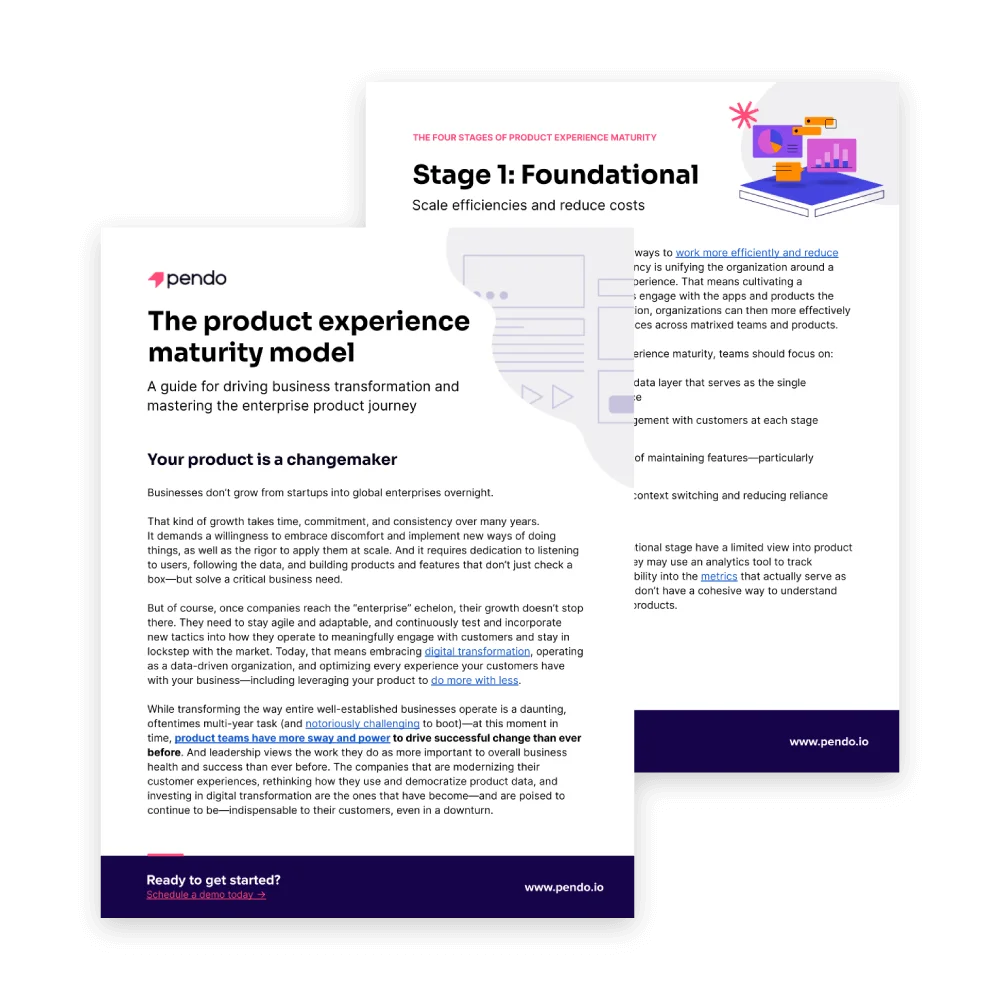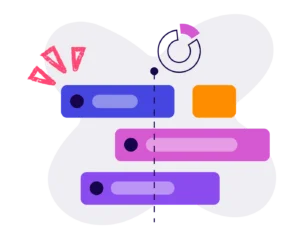
目次
In a rush? Download the PDF for later
Download the ホワイトペーパープロダクトはチェンジメーカーである
企業は、一夜にしてスタートアップ企業からグローバル企業に成長するわけではありません。
そのような成長には、時間とコミットメント、そして長年にわたる一貫性が必要となります。そのためには、違和感を受け入れ、新しいやり方を導入する意欲と、それを大規模に適用する厳格さが求められます。また、ユーザーの声に耳を傾け、データに従い、単に要件を満たすだけでなく、重要なビジネスニーズを解決するプロダクトやフィーチャーを構築することに専念する必要があります。
But of course, once companies reach the “enterprise” echelon, their growth doesn’t stop there. They need to stay agile and adaptable, and continuously test and incorporate new tactics into how they operate to meaningfully engage with customers and stay in lockstep with the market. Today, that means embracing digital transformation, operating as a data-driven organization, and optimizing every experience your customers have with your business—including leveraging your product to do more with less.
While transforming the way entire well-established businesses operate is a daunting, oftentimes multi-year task (and notoriously challenging to boot)—at this moment in time, product teams have more sway and power to drive successful change than ever before. And leadership views the work they do as more important to overall business health and success than ever before. The companies that are modernizing their customer experiences, rethinking how they use and democratize product data, and investing in digital transformation are the ones that have become—and are poised to continue to be—indispensable to their customers, even in a downturn.
The product experience maturity model is a framework to guide and empower product teams to lead change and digital transformation in their organizations, while optimizing the product experience and driving growth for the business. Think about it as a hierarchy of needs: By understanding what each stage of maturity looks like—and how to leverage product experience tools like Pendo to improve how you and your product function at each step—you’ll be better able to delight your customers and slingshot your entire organization into its next stage of growth.


ステージ 1 — 基礎
効率性を高めコストを削減
More than ever before, companies must find ways to work more efficiently and reduce operational waste. A pillar of business efficiency is unifying the organization around a single source of truth about the customer experience. That means cultivating a data-driven understanding of how customers engage with the apps and products the company produces. Armed with this information, organizations can then more effectively measure—and influence—customer experiences across matrixed teams and products.
So, in the foundational stage of product experience maturity, teams should focus on:
- プロダクトのパフォーマンスの信頼できる唯一の情報源として機能し、基礎となる民主化されたデータ層を構築する
- アプリ内メッセージを使用して、ジャーニーの各段階で顧客とのエンゲージメントを促進する
- フィーチャー、特に未使用または十分に使用されていないフィーチャーの維持にかかるコストと価値の比率を理解する
- コンテキストの切り替えを排除し、エンジニアリングリソースへの依存を軽減することで生産性を向上する
Most large organizations entering the foundational stage have a limited view into product engagement across their portfolios. While they may use an analytics tool to track high-level stats like pageviews, they lack visibility into the metrics that actually serve as indicators of user health and happiness, and don’t have a cohesive way to understand how their users move through and between products.
このようなデータへのアクセスは、意思決定に役立つデータにアクセスし理解できるチームが非常に少ないデータレイクでは制限され、技術者以外のチームが利用することができなくなってしまいます。つまり、プロダクトに関わるさまざまなチームが、重要なデータに対して一貫したアクセス方法がないまま作業することになるのです。そして、顧客や従業員のジャーニーに関する知識が共有されていなければ、最終プロダクトは矛盾したバラバラなユーザー体験を提供することになります。
Oftentimes, product teams are also heavily reliant on engineering to make changes (no matter how big or small) to the product. Without access to self-service in-app messaging tools, product teams can’t deliver timely guidance to customers or employees, disseminate updates that could benefit the entire user base (or even just a segment of affected users), or provide proactive support to struggling users. Instead, they’re forced to wait for the next scheduled development release to request such changes or additions. In the meantime, they face a flood of support tickets and requests from disgruntled users—most of which could have been mitigated with a simple in-app alert.
Operationally, teams throughout foundational-stage enterprises are likely to spend a lot of time in 1:1 engagements with customers—regardless of the value of those accounts. For example, customer success managers (CSMs) and onboarding specialists may spend hundreds of hours helping customers with routine activities like new user onboarding or basic product walkthroughs—taking away time and attention they could be devoting to more bespoke services for their highest-value relationships.
最後に、基礎段階の組織は通常、ポートフォリオ内のどのプロダクトやフィーチャーが実際にビジネスの価値を推進しているのか、また、どれが十分に活用されておらず、廃止される可能性が高いのかを特定する方法がありません。これにより、実際に変化をもたらさないプロダクトに過剰な時間、労力、リソースが浪費されることになります。
基礎的なプロダクト体験では、次のことが可能になります。
- プロダクト内のバリュードライバー(価値を高める要素)を特定する
- リソース投資を定量化する
- ビジネス全体でプロダクトのKPIを標準化する
- アプリケーション全体でのROIを明確にする
- 体験や取り組みの目標を明確にする
主な戦術:
- Create a foundational data strategy by using product analytics tools to get closer to users and understand how they’re moving across and within products and features. If you’re using a solution like Pendo, establish a “power team” to lead the effort of standardizing visitor and account metadata, tagging pages and features as needed, standardizing product KPIs, and reporting in Pendo and across the organization.
- Nurture customers within your product or app using targeted in-app guides to drive engagement in the moments that matter. This will help reduce reliance on your customer-facing teams and improve the overall product experience.
- Create an accessible help center. Identify commonly requested resources or frequently asked questions, and make them available within your products in a centralized, in-app hub. This will also help deflect routine support tickets and empower your users to self-serve.

ステージ 2 — 競争優位性
顧客維持率と顧客ロイヤルティを向上
基礎的なデータ層が確立されたら、最も重要な時と場所、つまりプロダクト内で、より有意義な方法でユーザーと関わり、顧客リテンションとロイヤルティを高めることに重点を置きます。
In the competitive stage of product experience maturity, teams should focus on:
- 価値を提供する可能性が最も高いフィーチャーに対してユーザーを育成する
- ニーズを予測し、パーソナライズされたオンボーディングを通じてユーザーを導く
- 粘着性に関するKPIを設定してエンゲージメントを向上する(結果としてチャーンの減少につながる)
- ユーザーを支持者に育てる
Competitive-stage teams advance from establishing a solid foundational data layer to having a comprehensive view into user engagement across their various apps and product lines. They have clear KPIs and dashboards in place to measure success (and frequently derive actionable insights from them), democratizing data throughout the organization. They also share this data across product teams to help eliminate silos and encourage different business units to learn from each other. This creates a common language and—particularly for companies with large product portfolios—makes it easier for disparate teams to build more cohesive, user-friendly multi-product journeys.
Organizations at this level of maturity also continue to build off the work they started in the foundational stage to deepen their understanding of where they should spend their time and resources. They evaluate product and user engagement data to make informed decisions about which features or products to sunset, or which to invest more heavily in. These insights give product teams confidence in what they’re building and help them prioritize the initiatives they know will have the greatest impact on the business.
Most competitive-stage companies use in-app content to engage with a broad audience of users inside their products. They also leverage segment- and behavior-based guidance to further tailor their communications. By using product data to identify which users to engage with—and when—PMs, CSMs, marketers, and salespeople can reach the right users at the right time using personalized messaging that drives desired behaviors and deepens account penetration.
競争優位性段階のプロダクト体験では、次のことが可能になります。
- プロダクト体験とビジネスニーズの整合性を高める
- オムニチャネル戦略を活用して、適切なタイミングでユーザーと関わる
- プロダクトポートフォリオ全体でデータモデルを標準化
- データを継続的に活用して意思決定に役立てる
主な戦術:
- Leverage product analytics to identify features or apps driving meaningful user engagement to help determine where to invest or divest budget and resources.
- Use segmentation to target key cohorts of users to analyze behavior and target in-app guides.
- Enable the right teams within your business with product analytics reporting on an ongoing cadence—to enable data-driven decision-making and clearly tie findings to business outcomes.
- Assemble an in-app guide governance team and create documentation to provide oversight, mitigate redundancy, and ensure consistent standards are met whenever in-app guides are deployed.

ステージ 3 — ベストインクラス
デジタル体験から収益増加を促進
プロダクト体験の成熟度がベストインクラスの段階に達した企業は、それまで効率性を妨げ、チームの時間とエネルギーを浪費していた日常的なプロセスの多くを自動化する方向に進みます。
At the best-in-class stage of product experience maturity, teams should focus on:
- ユーザーエンゲージメント、機能の定着化、継続的なリテンションのための共有目標に基づいて部門の枠を超えてチームを連携させる
- プロダクト施策が収益増加の促進にどのように貢献しているかを明確にする
- ユーザーおよび行動ベースのデータ値を活用して、顧客のジャーニーの各段階に基づきパーソナライズされた体験を自動化します。
ベストインクラスの組織は、プロダクトデータを高度に理解し、収益を特定のプロダクト施策に帰属させることができます。また、データに基づいたアプリ内コミュニケーション戦略を活用して、ユーザージャーニー全体を通じて効率を高め、収益性を高めています。
この成熟度の企業は、自社のプロダクト体験が全体的な顧客体験の中心であることも認識しています。教育やユーザーのセンチメント測定といった重要なタッチポイントやリソースをプロダクト内部に直接導入することで、ユーザーの生産性を高めています。そうすることで、顧客との重要なエンゲージメントを促進するためにアウトバウンドチャネルに頼る必要がなくなり、コストを節約し、社内チームがより戦略的な取り組みに着手できるようになります。
As they scale their product experience initiatives, best-in-class-stage organizations evolve their “power team” into a center of excellence (COE) to provide oversight over all their product-led initiatives across the product organization. This cross-functional group champions the product experience, advises on best practices, and upholds clear governance standards around activities like in-app guidance and reporting.
ベストインクラスのプロダクト体験では、次のことが可能になります。
- ユーザーとその行動に関するデータを活用した、ユーザージャーニーのパーソナライズと自動化する
- 行動ベースのトリガーを使用して、より深いエンゲージメントを促進する
- プロダクトの使用状況データを継続、アップセル、クロスセル戦略に一貫して結び付ける
- 顧客の健全性を測定し、より広範な顧客体験への取り組みを提供するために、定量的および定性的両方のインサイトを総合的に活用する
主な戦術:
- Integrate your product experience system of record with other key tools used throughout the organization, so that your product data becomes the driving force behind all decisions—and so you can see how your product directly impacts profitability.
- Build a scalable in-app personalization strategy using product data and segmentation. Drive all key customer touchpoints inside the product to reduce friction and accelerate sales cycles.
- フィーチャーの定着化データを活用して、関連する顧客とのタッチポイントを自動化することで、ジャーニーの主要段階をつなげます。

ステージ 4 — 変革
高いROIでより迅速なイノベーションを実現
Companies operating at the transformative stage of product experience maturity deliver a seamless user journey within and across their apps and products, and operate at the highest levels of efficiency. They have built a strong, digital-first culture that puts their products at the center of their customer experience, and leverage product data to make informed decisions that drive the business forward.
At the transformative stage, teams should focus on:
- ダウンストリームの収益への影響に直接関係する、顧客の意見に基づいたロードマップを構築する
- カスタマージャーニーから得られるプロダクトデータや使用状況データを他のシステムの重要なデータ値と組み合わせて、プロダクト施策をビジネスの成長の重要な段階に合わせる
変革期の企業では、組織全体でさまざまなアプリやプロダクト分野に取り組んでいるチームが、プロダクトデータの信頼できる単一の情報源を共有しています。これらの主要なデータ値は、同社の他の技術スタックと完全に統合されており、定量的なパフォーマンス指標と定性的なフィードバックを容易に関連付けることができます。また、機会のあるエリアを特定し、トレンドを見つけ出し、ユーザーとの関係を結ぶことがシームレスになります。
これらの取り組みは、部門間の効率を高め、無秩序な増加を抑え、支出を統合し、コストを削減する、スケーラブルで自動化された戦略を推進することにより、会社の包括的な変革戦略を推進する重要な役割を果たしています。
変革期のプロダクト体験では、次のことが可能になります。
- プロダクトのユーザー行動データを他のビジネスクリティカルなデータと統合して、顧客体験とビジネスへの影響についての統一されたビューを作成します。
- 組織全体のチームがデータを活用してどのようにプロダクトと顧客体験を向上させるかの運用化および標準化を行う
- プロダクトの開発、展開、定着化を加速する
主な戦術:
- プロダクトチームとビジネスチーム間のフィードバックループを自動化する
- プロダクトのユーザー行動データと広範な技術スタックを統合する
- カスタマージャーニーに対する360度の全体的な視点をもとに一貫して業務を遂行する
より良いプロダクト体験を大規模に構築する準備はできていますか?
- Learn four ways your product can accelerate your business in this report
- Hear first-hand perspectives from leaders and practitioners in companies who are prioritizing their product experience in the top 10 product-led talks of the year video series
- Find out how becoming product led improves every aspect of the customer experience (and how to get started) on the Product-led Hub
- See some of the amazing things our customers have achieved by using Pendo to power their product-led strategy
- Request a custom demo to find out how Pendo can help you digitally transform your business and improve your product experience

